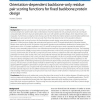146 search results - page 11 / 30 » Evolutionary design of the energy function for protein struc... |
CPM
2004
Springer
14 years 27 days ago
2004
Springer
In this paper we investigate the protein sequence design (PSD) problem (also known as the inverse protein folding problem) under the Canonical model 4 on 2D and 3D lattices [12, 25...
BMCBI
2006
13 years 7 months ago
2006
Background: When accurate models for the divergent evolution of protein sequences are integrated with complementary biological information, such as folded protein structures, anal...
NAR
2007
13 years 7 months ago
2007
The SUPERFAMILY database provides protein domain assignments, at the SCOP ‘superfamily’ level, for the predicted protein sequences in over 400 completed genomes. A superfamily...
BMCBI
2010
2010
Orientation-dependent backbone-only residue pair scoring functions for fixed backbone protein design
13 years 7 months ago
Background: Empirical scoring functions have proven useful in protein structure modeling. Most such scoring functions depend on protein side chain conformations. However, backbone...
BMCBI
2008
13 years 7 months ago
2008
Background: Prediction of disulfide bridges from protein sequences is useful for characterizing structural and functional properties of proteins. Several methods based on differen...

